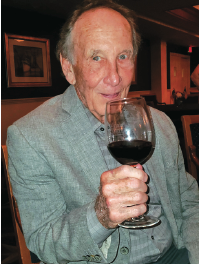S.W. and Rich Hermansen
Guest Writers
wine@lbknews.com
During the 1919-1933 era of Prohibition in the USA, the Happy Hour evolved as an interim  stop between work and home at one of the illegal purveyors of alcoholic beverages. The 18th amendment to the Constitution attempted to shut down the production and sale of spirits, wine, and beer.
stop between work and home at one of the illegal purveyors of alcoholic beverages. The 18th amendment to the Constitution attempted to shut down the production and sale of spirits, wine, and beer.
Speakeasies emerged by popular demand (and the winking eyes of local law enforcement) to serve cocktails, sparkling wines, and schooners of beer to legions of factory and office workers during the Roaring Twenties. Today the Happy Hour continues to serve as an interlude between work and home that often bridges work and family societies.
Except that now the “Hour” in “Happy Hour” has stretched to much longer intervals…. Even before the pandemic, and even more so after, meal times have strayed from breakfast in the morning, lunch at noon, and dinner in the evening to late brunches, afternoon dinners, and late suppers. Restaurants and bars have discovered commercial advantages in catering to anytime dining instead of rushed lunch and dinner hours.
Of course some of the drift toward meals at odd hours may result from diners looking for traditional hours for meals in other countries. The Italian espresso and biscotti or French cafe au lait and croissant mid morning, the Spanish and Mexican comida during mid afternoon followed by late evening tapas, and English tea and Scandinavian coffee during the late afternoon. Whatever the meal times, Happy Hours either serve apéritifs before these meal times or digestifs afterwards.
So we now have Happy Hours stretching from 2-6 or 4-7, or even from 11 to 7 on Fridays and weekends. For the after dinner drink or digestif, we have the Happy Hours beginning at 9-10PM and continuing until closing.
We enjoyed one such extended 9PM to closing Happy Hour at the venerable Café L’Europe on St. Armand’s Circle in Sarasota Florida. Acquired in 2022 by Amanda and John Horne, owners of the Ana Maria Oyster Bar restaurants, the Café L’Europe offers a Wine Down special 50% off wine bottles price on Wednesdays and a special Bar Bites menu featuring chilled lobster salad sliders, arancini (rice balls), and other tasty items on small plates. Tyler, behind the bar makes craft cocktails, but on this night we chose a bottle of the 2022 Stoller Pinor Noir from the Dundee region of the Willamette Valley of Oregon. The light and bright fruit flavors of this wine at the discounted price of $25, very close to retail, matched perfectly to the steak tartare and blue cheese arancini.
Happy Hours offer many options beginning during the early afternoon, and some before noon, for casual dining until late in the evening.
In our experience, Happy Hours attract interesting and sociable crowds Most bars and restaurants set aside an hour or so each day for a Happy Hour. Find your favorite hangout and enjoy the moment.
S.W. Hermansen has used his expertise in econometrics, data science and epidemiology to help develop research databases for the Pentagon, the National Institutes of Health, the Department of Agriculture, and Health Resources and Services. He has visited premier vineyards and taste wines from major appellations in California, Oregon, New York State, and internationally from Tuscany and the Piedmont in Italy, the Ribera del Duero in Spain, the Barossa Valley and McLaren Vale in Australia, and the Otego Valley in New Zealand. Currently he splits time between residences in Chevy Chase, Maryland and St. Armand’s Circle in Florida.
Rich Hermansen selected has first wine list for a restaurant shortly after graduating from college with a degree in Mathematics. He has extensive service and management experience in the food and wine industry. Family and friends rate him as their favorite chef, bartender, and wine steward. He lives in Severna Park, Maryland.
